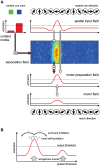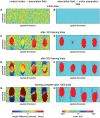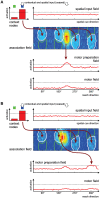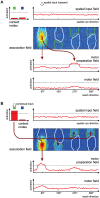Sensorimotor learning biases choice behavior: a learning neural field model for decision making
- PMID: 23166483
- PMCID: PMC3499253
- DOI: 10.1371/journal.pcbi.1002774
Sensorimotor learning biases choice behavior: a learning neural field model for decision making
Abstract
According to a prominent view of sensorimotor processing in primates, selection and specification of possible actions are not sequential operations. Rather, a decision for an action emerges from competition between different movement plans, which are specified and selected in parallel. For action choices which are based on ambiguous sensory input, the frontoparietal sensorimotor areas are considered part of the common underlying neural substrate for selection and specification of action. These areas have been shown capable of encoding alternative spatial motor goals in parallel during movement planning, and show signatures of competitive value-based selection among these goals. Since the same network is also involved in learning sensorimotor associations, competitive action selection (decision making) should not only be driven by the sensory evidence and expected reward in favor of either action, but also by the subject's learning history of different sensorimotor associations. Previous computational models of competitive neural decision making used predefined associations between sensory input and corresponding motor output. Such hard-wiring does not allow modeling of how decisions are influenced by sensorimotor learning or by changing reward contingencies. We present a dynamic neural field model which learns arbitrary sensorimotor associations with a reward-driven Hebbian learning algorithm. We show that the model accurately simulates the dynamics of action selection with different reward contingencies, as observed in monkey cortical recordings, and that it correctly predicted the pattern of choice errors in a control experiment. With our adaptive model we demonstrate how network plasticity, which is required for association learning and adaptation to new reward contingencies, can influence choice behavior. The field model provides an integrated and dynamic account for the operations of sensorimotor integration, working memory and action selection required for decision making in ambiguous choice situations.
Conflict of interest statement
The authors have declared that no competing interests exist.
Figures









Similar articles
-
Neural Signature of Value-Based Sensorimotor Prioritization in Humans.J Neurosci. 2017 Nov 1;37(44):10725-10737. doi: 10.1523/JNEUROSCI.1164-17.2017. Epub 2017 Oct 5. J Neurosci. 2017. PMID: 28982706 Free PMC article.
-
Normalization is a general neural mechanism for context-dependent decision making.Proc Natl Acad Sci U S A. 2013 Apr 9;110(15):6139-44. doi: 10.1073/pnas.1217854110. Epub 2013 Mar 25. Proc Natl Acad Sci U S A. 2013. PMID: 23530203 Free PMC article.
-
Contribution of sensorimotor beta oscillations during value-based action selection.Behav Brain Res. 2019 Aug 5;368:111907. doi: 10.1016/j.bbr.2019.111907. Epub 2019 Apr 12. Behav Brain Res. 2019. PMID: 30986489
-
Reward-dependent learning in neuronal networks for planning and decision making.Prog Brain Res. 2000;126:217-29. doi: 10.1016/S0079-6123(00)26016-0. Prog Brain Res. 2000. PMID: 11105649 Review.
-
[Neural mechanisms of decision making].Brain Nerve. 2008 Sep;60(9):1017-27. Brain Nerve. 2008. PMID: 18807936 Review. Japanese.
Cited by
-
The Importance of Lateral Connections in the Parietal Cortex for Generating Motor Plans.PLoS One. 2015 Aug 7;10(8):e0134669. doi: 10.1371/journal.pone.0134669. eCollection 2015. PLoS One. 2015. PMID: 26252871 Free PMC article.
-
Model-based functional neuroimaging using dynamic neural fields: An integrative cognitive neuroscience approach.J Math Psychol. 2017 Feb;76(Pt B):212-235. doi: 10.1016/j.jmp.2016.11.002. Epub 2016 Dec 21. J Math Psychol. 2017. PMID: 29118459 Free PMC article.
-
Hand Shape Representations in the Human Posterior Parietal Cortex.J Neurosci. 2015 Nov 18;35(46):15466-76. doi: 10.1523/JNEUROSCI.2747-15.2015. J Neurosci. 2015. PMID: 26586832 Free PMC article.
-
Single reach plans in dorsal premotor cortex during a two-target task.Nat Commun. 2018 Sep 3;9(1):3556. doi: 10.1038/s41467-018-05959-y. Nat Commun. 2018. PMID: 30177686 Free PMC article.
-
Hedging your bets: intermediate movements as optimal behavior in the context of an incomplete decision.PLoS Comput Biol. 2015 Mar 30;11(3):e1004171. doi: 10.1371/journal.pcbi.1004171. eCollection 2015 Mar. PLoS Comput Biol. 2015. PMID: 25821964 Free PMC article.
References
-
- Tversky A, Kahneman D (1981) The Framing of Decisions and the Psychology of Choice. Science 211: 453–458 doi:10.1126/science.7455683 - DOI - PubMed
-
- Cisek P, Kalaska JF (2010) Neural mechanisms for interacting with a world full of action choices. Annu Rev Neurosci 33: 269–298. - PubMed
-
- Andersen RA, Cui H (2009) Intention, Action Planning, and Decision Making in Parietal-Frontal Circuits. Neuron 63: 568–583 doi:10.1016/j.neuron.2009.08.028 - DOI - PubMed
-
- Klaes C, Westendorff S, Chakrabarti S, Gail A (2011) Choosing Goals, Not Rules: Deciding among Rule-Based Action Plans. Neuron 70: 536–548 doi:10.1016/j.neuron.2011.02.053 - DOI - PubMed
Publication types
MeSH terms
LinkOut - more resources
Full Text Sources

